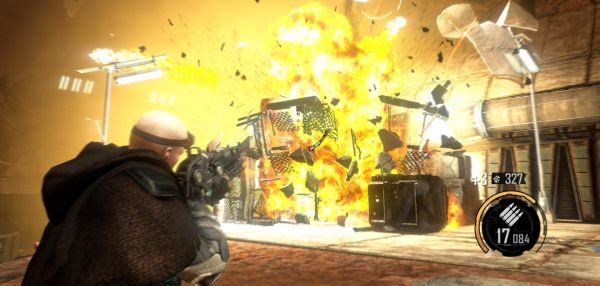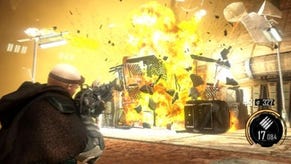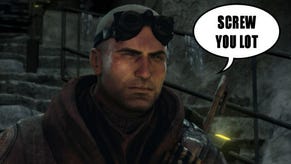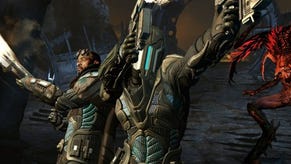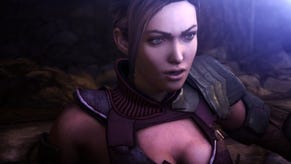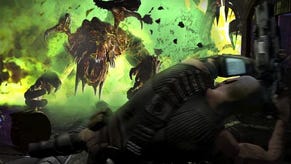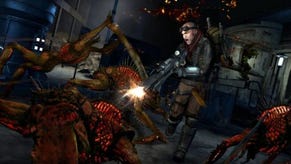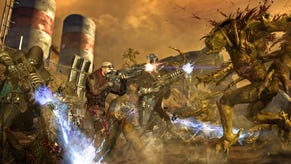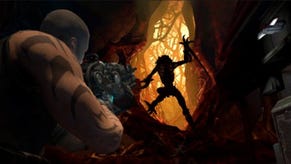Wot I Think: Red Faction Armageddon
Hit it with a hammer
Volition's Red Faction: Armageddon has been out for a few days, surprising many with the direction it's taken for its hammer/magnet based destruction. Having smashed every last thing from beginning to end, I'm now in a position to tell you Wot I Think.
Red Faction: Armageddon is extraordinary. No game has ever offered such destruction, let alone on such an epic scale. It’s ability to let you use the environment itself as your primary weapon is unsurpassed. The sense of sheer power, and constant, remarkable devastation, is a treat. Red Faction Armageddon, however, makes one big mistake: Red Faction Guerrilla.
If there were no expectations of the series, if this were the first game in a new franchise, it would be being heralded as one of the most pure fun corridor shooters in ages. Because it is, without a doubt, one of the most pure fun corridor shooters in ages. The problem is, it’s a corridor shooter, in a sequel to its gloriously open world predecessor. And it’s never clear why.
The setting is pure sci-fi hokem, the likes of which you’ve seen in a dozen Dune rip-offs. The surface of Mars is getting too dangerous for human life, the colonists have fled underground, and a new enemy is appearing in the form of some local beasties. Feeling responsible for the disaster, hero Darius Mason (indeed yet another in the Mason dynasty) sets about killing everything that’s spiny on his own.
The plot, such as it is, is convoluted and haphazard, muddling two or three main themes – fighting the evil Adam Hale, battling Martian creatures, rescuing various people – and the pacing is downright peculiar. It feels like it’s about to end multiple times from about the midway point onward, which ends up being confusing rather than frustrating.
But all of that can be ignored thanks to one thing: The Magnet Gun. It’s the best thing in a shooter since the Gravity Gun, and everything else I play from now on is going to feel like a relic. Given to you amazingly early on, this tool can attach one magnet to any destructible object or enemy, and then a second to anything else. The first is torn away to clash with the second with destructive force. Which means you get to smash up everything.
I barely used any of the very many other weapons, as fantastic as some of them are, because why would I want to do anything else but kill the enemies by pulling a bridge onto their heads? Why use the epic Singularity Canon when I can send a beast flying through the air to smash its brains out on the cave ceiling? Yes, it really is amazing that one of the game’s arachnoid mechanical walkers has a Napalm Laser, but I’ve got a tool that lets me pick up chunks of building and throw them at towering pylons.
Actually, I can’t take too much away from the Napalm Laser. What a toy. You get a few seconds to wave the laser beam around at all in front of you, and then everywhere it touched violently explodes. It’s insane, and enormously fun.
However, where the trusty magnet cannot distract you is from the dramatic change in direction for the series. When the game was first announced, revealing that it would be set underground, there were fears that this would mean the focus on destructible environments would be lost. That couldn’t be further from the truth. But what no one was expecting was that it would become a completely linear, zero-choice, straight-line shooter.
Guerrilla was a collection of challenges, spawning from a series of hubs. Alongside the main quest were many smaller tasks, usually involving destroying something in a particular way. There were enclaves to take over, buildings to wipe out using a limited number of ammo types, mech suit sections, and so on. They were challenges, set within the story’s larger world. And while some of those elements appear here, they’re tightly woven into the core path.
So there’s still a couple of sequences with a mech suit, and they’re still great fun. But they feel as if they were added in as an afterthought, “Well, we’d better have a couple of mech sections, I suppose.” Vehicles are only available when the level calls for it, rather than being something you can hop in to explore. And there are no mini-challenges whatsoever.
There’s also the rather peculiar addition of incessant cutscenes. And they’re weirdly implemented, too. Bothersomely stealing the controls from you far too often, they often feel disjointed, not quite matching up to the scene they took you from, or seeming to end nowhere near where you next start playing. A sequence may end with your reaching an elevator to take you to the surface, and then jump to a cutscene where you’re already up top, having been arrested. Huh?
That doesn’t mean it isn’t still enormously – no – rapturously fun to smash everything to smithereens. It’s such a ludicrous pleasure, ripping everything but for the cave walls themselves to pieces, scattering them across the vast caverns, obliterating waves of enemies as enormous structures come tumbling down. And this time you can tidy up after yourself!
You’ve this nano-doodah, which has various purposes. You can use its Impact function to blast away a large group of baddies, or suspend them in the air with X, both of which are enormous fun. But best of all is Restore. Hold this down and you’ll start putting everything back where it was, the buildings restoring themselves around you piece by piece. It’s an incredible site, walls, structures, and most importantly, pathways slotting themselves back together. In a game where just about everything can be thrown around, that means the paths and ramps too. And you might be needing those later. Running along as you recreate a walkway in front of you is pure damned magic, and made me feel like the greatest wizard every single time.
It’s also a great means of ensuring you have cover during the more intense firefights, of which there are an awful lot. And indeed more stuff to pick up and throw at the vast plant-like towering creatures that are throwing scenery back at you. Other enemies move amazingly well, leaping from wall to wall, zipping at remarkable speeds, making excellent foils. And making it all the more satisfying when you catch them with the magnet and fling them into the distance.
However, as you’re taking great relish in bringing down a four-storey building, collecting he nanergy drops to let you unlock further abilities and bonuses, the game will not stop nagging you.
Where Guerrilla rewarded you mightily for wiping out everything you saw, Armageddon (why do they pick subtitles I can never spell first time? – the next game is bound to be called Red Faction: Manoeuvres) seems to get actively annoyed with you for hanging around. At any point you can hit Tab to see the highlight path you should take (while the game is undeniably linear, there are dead ends and occasional alternative paths), but this feature starts frantically firing itself off, while an on-screen message insists that you complete the next task. On top of this your buddies on the radio will start shouting at you to get on with it. And you’ve got SAM, your Situation and Awareness Module computer buddy, starts telling you off as well. It’s ridiculous.
It's also worth noting that with Volition's promises to treat the PC as an equal, it runs utterly smoothly, switches between PC and 360 controls seamlessly, and runs wonderfully in a borderless window. It's a shame that you'll still be clicking to start, and be constantly warned not to switch off your system while it's saving - it would have been nice if they could have cleared that up.
Which all leaves Armageddon in a strange place. Were it not for its past, this would be celebrated for what it is, and perhaps it should be. But it’s impossible not to miss what’s lost. Convinced that at some point the seeming base my buddies were in would eventually become my hub, I was inevitably disappointed to learn otherwise. And being underground, the opportunities for the variety of locations the previous game offered are gone, leaving you with mostly blue and brown.
But that doesn’t mean I didn’t have an often fantastic time as I smashed and crashed through the ten-or-so hours. I really did. Certainly it reaches a point of extreme padding in the final stretch, with interesting boss fights (no, really – and even with checkpoints midway through) and a fun boat-riding sequence breaking up some extremely repetitive combat sequences. It also seems to forget itself, offering less stuff to fling around, forcing you to rely on weapons and shields. The very final battle obviously should have been a destruction special, asking you to demolish some vast building, but sadly is nothing of the sort. In fact, it’s a bit of a repetition of an earlier sequence.
That’s the Red Faction: Armageddon experience, really. It feels great, it’s an unquestionably extraordinary achievement of destruction fun, but then you want to tag something on the end saying where it falls short. Which probably isn’t fair. In isolation, a completely top fun shooter. In the RF series, a peculiar direction. Worth playing? I say so.


